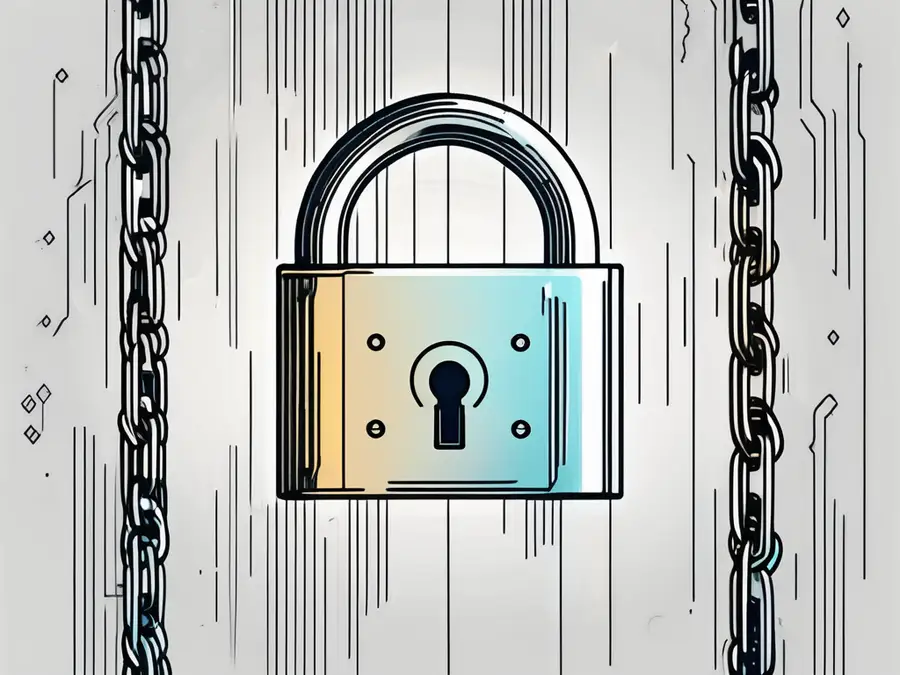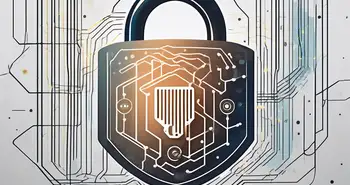The Role of Cryptography in Blockchain Technology

Cryptography plays a vital role in the world of blockchain technology, serving as the backbone for its security and privacy. Understanding how cryptography and blockchain intersect is crucial in comprehending the inner workings of this revolutionary technology.
Understanding Cryptography and Blockchain
Defining Cryptography
Cryptography is the practice of securing communication from malicious third parties by converting information into a form that is unreadable to unauthorized individuals. It involves the use of mathematical algorithms, keys, and protocols to ensure confidentiality, integrity, and authenticity.
One of the key components of cryptography is encryption, where data is encoded to prevent unauthorized access. This process uses complex mathematical algorithms to scramble the information in a way that can only be deciphered by those with the corresponding decryption key. Cryptography plays a crucial role in various aspects of modern technology, from securing online transactions to protecting sensitive information in government communications.
The Basics of Blockchain Technology
Blockchain is a distributed ledger technology that records transactions in a decentralized and immutable manner. It is made up of a chain of blocks, where each block holds a set of transactions. What sets blockchain apart is its transparency, security, and resistance to tampering.
Every transaction on the blockchain is verified by participants known as validators, who use consensus algorithms to agree on the validity of the transaction. Once a transaction is validated, it becomes a part of the blockchain, which is stored across multiple nodes in a network.
Blockchain technology has gained significant attention for its potential applications beyond cryptocurrencies. Industries such as supply chain management, healthcare, and voting systems are exploring the use of blockchain to increase transparency, streamline processes, and enhance security. The decentralized nature of blockchain ensures that there is no single point of failure, making it a robust solution for storing sensitive data and facilitating trustless transactions.
The Intersection of Cryptography and Blockchain
The Importance of Cryptography in Blockchain
Cryptography forms the foundation of blockchain technology, ensuring the integrity and security of transactions. It allows participants to interact with the blockchain while keeping their sensitive information private.
Without cryptography, the immutability of the blockchain and the trust participants place in it would be compromised. Cryptographic techniques protect the authenticity of transactions, preventing fraud and tampering.
Moreover, cryptography in blockchain extends beyond transaction security. It also plays a crucial role in consensus mechanisms, such as Proof of Work and Proof of Stake, which are essential for maintaining the decentralized nature of blockchain networks. These mechanisms rely on cryptographic puzzles and algorithms to validate transactions and create new blocks, ensuring the network's security and efficiency.
How Cryptography Secures Blockchain Transactions
Cryptographic techniques such as digital signatures, hash functions, and public-key cryptography play a crucial role in securing blockchain transactions.
Digital signatures verify the authenticity and integrity of transactions, ensuring that they cannot be altered without detection. Hash functions create unique digital fingerprints for each block, making it nearly impossible to modify a block without changing the entire chain.
Public-key cryptography enables participants to securely exchange information and establish a trusted network without prior knowledge of each other. It allows for secure encryption, decryption, and digital identification, enhancing privacy and trust in the blockchain.
Furthermore, the use of cryptographic keys in blockchain technology provides a secure way to manage access control and permissions within the network. These keys, which are generated and stored securely by participants, serve as digital identities that authenticate and authorize transactions, adding an extra layer of security to the blockchain ecosystem.
Different Cryptographic Techniques Used in Blockchain
Hash Functions in Blockchain
Hash functions are essential cryptographic tools used to maintain data integrity and security in blockchain. They generate fixed-size, unique outputs (hashes) based on the input data, regardless of the size of the input.
Hash functions are used to create the digital fingerprints of blocks in the blockchain. Any change in the input data, no matter how small, will result in a completely different hash value. This property makes it easy to verify the integrity of the entire blockchain.
Moreover, hash functions play a crucial role in mining new blocks in a blockchain network. Miners compete to find a nonce value that, when combined with the block data, produces a hash value that meets certain criteria, such as a specific number of leading zeros. This process, known as proof of work, not only secures the network but also incentivizes miners with block rewards for their computational efforts.
Public Key Cryptography in Blockchain
Public key cryptography, also known as asymmetric cryptography, enables secure communication between participants in a blockchain network without the need for prior trust or a centralized authority.
It leverages the use of two keys: a public key for encryption and a private key for decryption. Participants can publicly share their public key, allowing others to encrypt messages or transactions that only the corresponding private key can decrypt. This ensures the confidentiality and integrity of data exchange in the blockchain.
Furthermore, public key cryptography is fundamental in establishing digital signatures in blockchain transactions. When a user initiates a transaction, they sign it with their private key, which can be verified by anyone using the user's public key. This process guarantees the authenticity of the transaction and prevents tampering or unauthorized alterations.
The Role of Cryptography in Blockchain Privacy
Ensuring Anonymity with Cryptography
Cryptography plays a crucial role in maintaining the anonymity of participants in a blockchain network. While blockchain transactions are transparent and visible to all, the identities of the individuals involved can remain anonymous.
By using cryptographic techniques such as stealth addresses and ring signatures, participants can carry out transactions without revealing their actual public addresses, making it difficult to trace their real identities. This privacy feature enhances security and fosters trust in blockchain systems.
Cryptography and Data Protection in Blockchain
Cryptography safeguards sensitive data in blockchain systems by encrypting it, making it unintelligible to unauthorized users. Only those with the appropriate decryption keys can access and view the data.
By encrypting data at rest and in motion, blockchain systems ensure that even if a breach occurs, the stolen data remains protected and unusable to attackers. This encryption adds an extra layer of security to the blockchain ecosystem, making it an attractive option for industries handling sensitive information.
Cryptography and Blockchain Security
The Role of Cryptography in Preventing Double Spending
Double spending refers to the fraudulent act of spending the same cryptocurrency more than once. Cryptography prevents double spending by ensuring the integrity and uniqueness of transactions on the blockchain.
With cryptographic techniques like digital signatures and consensus algorithms, double spending becomes virtually impossible. Each transaction is digitally signed, ensuring that it can only be spent once and verified by the blockchain network.
Cryptography in Mitigating Blockchain Attacks
Cryptography helps defend against various types of attacks that can compromise the security and integrity of a blockchain.
For example, by incorporating cryptographic mechanisms like Merkle trees, blockchain networks can resist issues like data manipulation and tampering. Merkle trees allow for efficient verification of the integrity of large sets of data, making it difficult for attackers to alter transaction history without detection.
Personal Advice: As an expert in the field of blockchain and cryptography, I would advise individuals and organizations looking to leverage blockchain technology to prioritize security and privacy. Understanding the role of cryptography and implementing robust cryptographic techniques is crucial in safeguarding sensitive data and maintaining trust in the blockchain ecosystem.
FAQ – Frequently Asked Questions
What is the role of cryptography in blockchain?
Cryptography is fundamental to the security and privacy of blockchain technology. It ensures the integrity of transactions, protects sensitive information, and prevents fraudulent activities such as double spending.
How does cryptography secure blockchain transactions?
Cryptographic techniques like digital signatures, hash functions, and public-key cryptography ensure the authenticity, integrity, and privacy of blockchain transactions. They provide mechanisms to verify the validity of transactions, protect against tampering, and enable secure communication between participants.
What are some cryptographic techniques used in blockchain?
Hash functions are key cryptographic tools used to create unique digital fingerprints and maintain data integrity. Public-key cryptography enables secure communication and establishes trust in a decentralized network.
How does cryptography enhance privacy in blockchain?
Cryptography enables anonymity in blockchain systems through techniques like stealth addresses and ring signatures. It also protects sensitive data by encrypting it, making it unintelligible to unauthorized users.
How does cryptography support blockchain security?
Cryptography plays a vital role in preventing double spending and mitigating various types of attacks in the blockchain ecosystem. Mechanisms like digital signatures and Merkle trees ensure transaction integrity and provide robust defenses against tampering and data manipulation.
Now that you understand the pivotal role cryptography plays in enhancing the security and privacy of blockchain technology, it's time to put that knowledge into action with Morpher. Embrace the future of trading on a platform that harnesses the power of blockchain to offer zero fees, infinite liquidity, and a truly unique trading experience. Whether you're interested in stocks, cryptocurrencies, or even niche markets like NFTs and sneakers, Morpher provides the tools you need for fractional investing, short selling, and up to 10x leverage. Sign up today at Morpher.com and receive your free sign-up bonus to start trading with the safety and control you deserve.

Disclaimer: All investments involve risk, and the past performance of a security, industry, sector, market, financial product, trading strategy, or individual’s trading does not guarantee future results or returns. Investors are fully responsible for any investment decisions they make. Such decisions should be based solely on an evaluation of their financial circumstances, investment objectives, risk tolerance, and liquidity needs. This post does not constitute investment advice.

Painless trading for everyone
Hundreds of markets all in one place - Apple, Bitcoin, Gold, Watches, NFTs, Sneakers and so much more.

Painless trading for everyone
Hundreds of markets all in one place - Apple, Bitcoin, Gold, Watches, NFTs, Sneakers and so much more.









